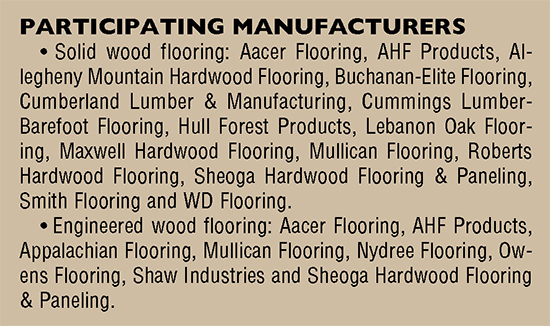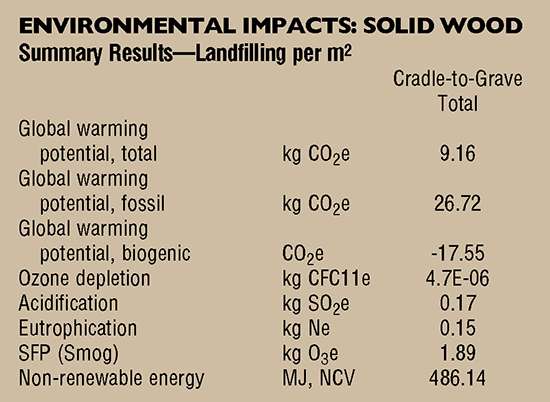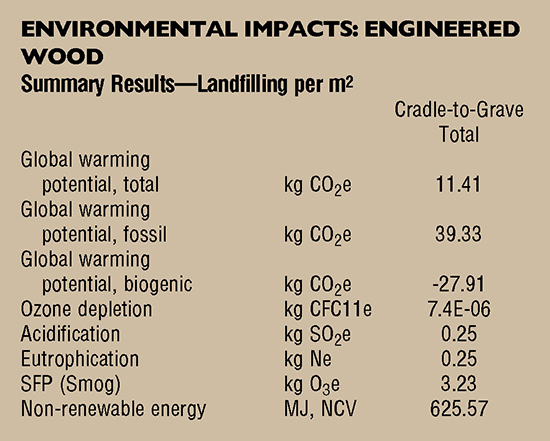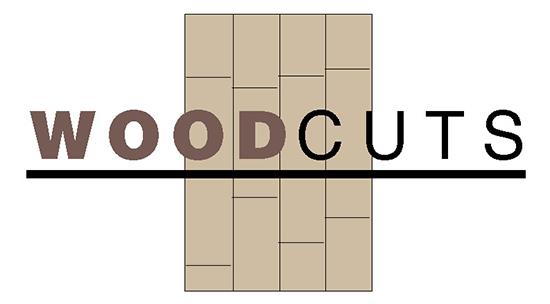Wood Cuts: Conveying the benefits of real wood flooring - April 2023
By Michael Martin
For years, flooring manufacturers of all categories have marketed their products as being environmentally friendly, but there has been little concrete data to support these claims. The recent publication of two environmental product declarations (EPDs) for real wood floors now provides scientific data to prove that real wood floors contribute to the overall health of our planet.
EPD OVERVIEW
The EPDs were commissioned by the National Wood Flooring Association (NWFA) and the Decorative Hardwoods Association (DHA) and developed by the Athena Sustainable Materials Institute. One EPD was produced for solid wood flooring, and one was produced for engineered wood flooring.
EPDs are comprehensive documents that provide scientific data, verified by a third party, outlining the environmental impacts of a specific product during its entire lifecycle, from cradle to grave. For real wood floors, this includes raw material extraction (tree harvesting), primary manufacturing into lumber, secondary manufacturing into flooring, packaging, transportation, installation, service life, and end of life or disposal.
A practical benefit of EPDs is that they communicate complex scientific data in a way that is easy to understand, functioning like nutrition labels on food products. This can be important for retail sales associates (RSAs), since consumers increasingly are demanding transparency about the environmental impacts and long-term health implications of the products they buy. EPDs are required to report information such as global warming potential (GWP), ozone depletion, smog creation and water pollution.
To acquire the information needed to produce these two EPDs, a large group of wood flooring manufacturers collected and provided detailed production data during the course of a year. The participating manufacturers represented a substantial percentage of industry production, meaning that the calculated environmental impacts accurately represent the industry as a whole. The data provided by the 18 companies included total material inputs, co-products produced, water usage, type and amount of fuel used, waste materials produced, atmospheric emissions, and total wood flooring output.

THE FINDINGS
The results of the NWFA/DHA EPDs show that both solid and engineered wood flooring have a noticeably smaller carbon footprint, or GWP, than all other flooring product categories. Carbon efficiency and transparency increasingly determine capital investments and procurement decisions. As a result, EPDs are commonly used by builders, architects and specifiers to meet requirements for green building rating systems such as LEED v4.1. They also establish an industry benchmark that product-specific EPDs can be measured against, since products that are intended for the same use are bound to the same product category rules (PCRs). In other words, comparisons of like products are based on exactly the same scientific criteria. GWP for all EPDs is measured in kilograms of C02-equivalent gases, or how much CO2 is contributed to the atmosphere during the entire lifecycle of a product.
The EPD results for solid wood flooring are shown in Chart 1. It assumes that 100% of the flooring was sent to the landfill at the end of its service life. Impact measurements were for one square meter of flooring, which has 9.16 kg of CO2 equivalent gases. This figure is calculated by determining the total impacts caused by the use of fossil fuels, minus the potential CO2 that is stored in the product.
The EPD results for engineered wood flooring are shown in Chart 2. It also assumes that 100% of the flooring was sent to the landfill at the end of its service life, and impact measurements were for one square meter of flooring, which in this case has 11.41 kg of CO2 equivalent gases.

Solid and engineered wood flooring were also compared with competing flooring product categories for global warming potential. Both solid and engineered are the least impactful of all flooring products studied. These results are a mix of industry averaged EPDs and product-specific EPDs. Wood, ceramic tile and the various plastic products all have industry averaged EPDs that were commissioned by their respective associations.

Solid wood flooring (9.2) and engineered wood flooring (11.4) have the lowest GWP with the other categories as follows: ceramic tile (19.6), heterogeneous vinyl (26.1), lowest carpet tile (26.8), vinyl composition tile (26.9), homogeneous vinyl (29.2), vinyl tile (41.8), rubber (44.2), rigid core (64.3), lowest broadloom (75.7), highest carpet tile (241.8), and highest broadloom (432.9). Turn to page 41 to see this data in chart form.
A PLATFORM FOR REAL WOOD FLOORS
The environmental impact results for real wood floors can be a powerful selling tool for RSAs, but there are many differences among flooring products. Engineered wood floors, for example, can include a variety of core materials, as well as a variety of wearlayer thicknesses. The ability to refinish a wood floor, allowing it to last for generations, is the foundational attribute that traditionally has separated the category from all other flooring types. As the lines between hard surface categories have blurred, many RSAs need a reliable and verifiable way to identify engineered wood floors that can be refinished.
The NWFA Engineered Wood Flooring Refinishable Program is a voluntary certification designed to identify engineered wood flooring products with wearlayers thick enough to be refinished. This program is a simple tool designed to help RSAs and buyers cut through the clutter and identify refinishable real wood flooring products.
All types of engineered wood are eligible to apply to carry the Engineered Wood Flooring Refinishable logo. To qualify, wearlayer thicknesses must meet minimum industry standards:
• Unfinished smooth wood flooring=4/32” (3.2 mm)
• Factory finished smooth wood flooring=3/32” (2.5 mm)
• Sculpted/distressed wood flooring=3/32” (2.5 mm) at the lowest point
When addressing the sanding process for previously finished wood floors, the NWFA Wood Flooring Sand and Finish Guidelines state that, in general, if the wear thickness is less than 3/32”, the floor should not be sanded. For the sanding of distressed/sculpted floors, recognizing the variation in the surface wearlayer thickness of these products, the guidelines state that the wearlayer may be less than the recommended 3/32” thickness in many areas of the floor, which would become the lowest point that the remaining floor would need to be sanded to in order to get it flat.
Determining the wearlayer thickness benchmark for unfinished engineered wood flooring involves a little math. The National Oak Flooring Manufacturer’s Association (NOFMA) guidelines clearly stated prior to its merger with NWFA that the sanding operation should remove a minimal amount of wood, less than 1/32”. If approximately 1/32” of wood is removed from the wearlayer of an installed unfinished engineered wood floor with a 4/32” wearlayer, the result is a site-finished floor with a wearlayer approximately 3/32” thick, providing a refinishable wearlayer comparable to that of a newly installed factory finished wood floor. Dating back as far as 1916, standardized detail drawings for the thinnest solid unfinished wood floors (3/8”) show a 4/32” refinishable layer, allowing the resulting wood flooring product to be sanded and finished onsite and refinished at least once at a future date.
Launched less than a year ago, the program has been well-received within the industry. To date, more than a dozen manufacturers of unfinished wood flooring products have joined the program.
Copyright 2023 Floor Focus
Related Topics:Lumber Liquidators, NWFA Expo
